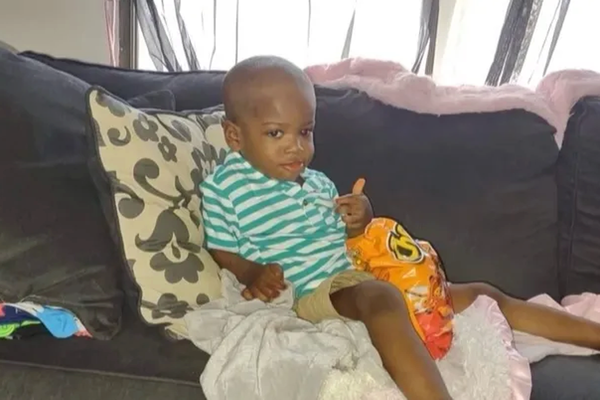

Queer mob have always existed. While our histories and roles in our pre-invasion societies are often obscured by the impacts of colonisation, we have always existed and continue to play significant roles in our communities.
Felicia Foxx is the drag moniker of Wendell French, a proud Kamilaroi and Dhunghutti “brotherboy, sistergirl, brista – brothersister” raised in Campbelltown, Western Sydney.

Since discovering drag at 16-years-old, Felicia has spent almost a decade in the industry — going from “little $150 gigs or [getting paid] through a bar tab for the night”, to becoming a regular and recognisable figure in Australian queer entertainment.
But the increase in jobs and pay isn’t the thing that excites Felicia the most when reflecting on their career; it’s the growth of their community in the space.
“Especially being of Aboriginal descent, I didn’t see myself [represented] when I did start at the age of 16,” they told PEDESTRIAN.TV.
“I’ve loved to see the growth within the queer Aboriginal drag community itself, to see how much it’s expanded, and to see plenty more brotherboys and sistergirls out there doing the art form of drag.”
While shows like Rupaul’s Drag Race have arguably brought drag to the mainstream, it merely scrapes the surface of the diversity of drag as a performance art. For Felicia, there isn’t a strict prerequisite to what drag can or should be, it “just screams authenticity and uniqueness”.
“It’s an art form that you can literally go out and experiment doing anything that you want, being anything that you want. Being someone that you normally wouldn’t be in your day to day life — as Wendell French, as I am, Felicia Foxx. You can just be more fierce, more stern in what you preach and what you believe in.”
For Felicia, drag has not just been a pathway to entertain but connect with themselves and the world around them.
“[Drag] gave so much room to experiment in finding my true identity as Wendell and Felicia. It has helped me form and shape myself as an Aboriginal human being on this earth in this day and age.”
Being Aboriginal and queer goes hand in hand for Felicia. It’s an enduring identity that dates back to far before invasion and continues into our contemporary community life as First Nations people.
“Queer Blackfella excellence is important. It needs to be put on a pedestal, it needs to have more representation, and it needs to have much more noise. Especially when it comes to our own Aboriginal community,” they said.
“I think it’s more important that they [our Aboriginal and queer community] uphold us, and celebrate us. There’s the struggle of us being Black, trying to live in today’s day and age in society, but to then go ahead and be queer and Black, and have all these other barriers that we have to hurdle in life.”

Felicia’s advocacy is ingrained into their drag, describing themselves as an “artivist” (artist/activist) who embeds politics into their performance.
“I see myself as a political person. Just being a Blackfella I was already born into an ancestry of strong people who were out on the front line and fighting for our rights as Aboriginal people,” they said.
Citing prominent Aboriginal advocates Lidia Thorpe, Aunty Gwenda Stanley, Aunty Lizzie Jarrett and Uncle Tiga Bayles as inspirations, Felicia is motivated by “the strong Black people that [they’ve] had around [them] in [their] life that have always been fighting that fight”.
Through this history and connection, Felicia transforms the stage into a site of activism.
“When I am performing in those spaces that are predominantly non-Indigenous, I love to use politics, and my activism in these spaces. I’m coming on stage with a message.”
Although clubs have sometimes been that safe space for expression, a big part of Felicia’s journey has been cultivating comfort and safety within themselves.
“No matter where I go in life, I think just as long as I am grabbing myself and keeping myself centered, I am most comfortable within being myself. My partner makes me feel so safe but before I met him, I am my home.”

“My supporters know that I am a recovering addict of ice. That drug did take a lot away from me in terms of self-esteem and being myself. It made me feel like Wendell wasn’t as good as Felicia, when now I know I can be 100 per cent comfortable in myself.”
At just 24, Felicia still feels they have a lot more to succeed, with Drag Race being a big dream and ultimately “being like an Aboriginal drag queen Ambassador of Australia”!
This Mardi Gras and beyond, Felicia wants their work to spread their message amongst non-Indigenous people in the queer community and beyond.
“It’s important that you all know our story, our walks of life, you know our journeys and that these things are put out there for the world to see. We exist, we have been existing, we’re still here and we’re still going strong.”

5 Quick Questions With Felicia
Favourite queer spot in Sydney?
Number one favorite would have to be the Imperial Hotel.
Favourite queer spot outside Sydney?
I know it’s still in Sydney but I love Koori-gras when it’s on at Carriageworks.
Fave queer book, queer movie, TV show or artist?
Number one is Queen Latifah (not enough people recognise that she’s a lesbian)!
Number one tip for surviving Mardi Gras?
Regardless of all the partying and everything in that, when it comes to our haters and all the people that don’t want to celebrate with us, stay off social media. Don’t go through the comment sections.
Support your brothers and sisters and our queer families, and just make sure that everyone is around supporting one another. And make sure you have plenty of Epsom salts for your feet after the march!
How would you describe your first crush with an emoji?
🕳️💦🍆
This story is part of our Mardi Gras digital issue, celebrating the LGBTQ+ culture makers and game changers who make this city thrive.

Read more from this issue:
- House Of Silky’s Father Xander Khoury on Ballroom’s Past, Present & Shining Future
- Heaps Gay’s Kat Dopper on Community, Chosen Family & Creating The Ultimate Vibe
- Kath Ebbs on Non-Binary Joy, the Pink Dollar, and Falling in Love Over Line Dancing
- Alix Higgins on Friends As Muses & Twisting Masculinity In Fashion
The post Felicia Foxx on Queer Blackfella Excellence & Change Through ‘Artivism’ appeared first on PEDESTRIAN.TV .







